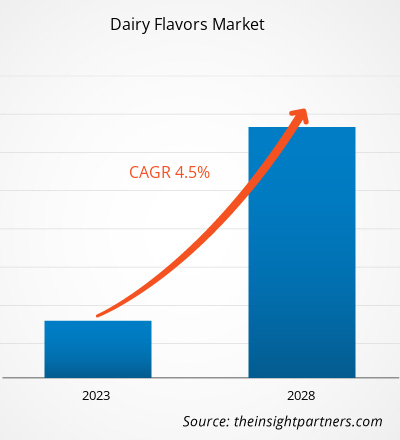Le marché des arômes laitiers devrait passer de 1 962,45 millions de dollars américains en 2022 à 2 552,19 millions de dollars américains en 2028 ; sa croissance devrait atteindre un TCAC de 4,5 % entre 2022 et 2028.
Les arômes laitiers sont des agents aromatisants ajoutés à divers produits alimentaires et boissons pour conférer la saveur des produits laitiers tels que le beurre, le fromage, la crème et le lait. Ils gagnent en popularité dans l'industrie agroalimentaire, car ils contribuent à conférer la saveur des produits laitiers sans augmenter la teneur en calories ou en matières grasses du produit. Les arômes laitiers sont transformés et fabriqués à partir de produits laitiers tels que le lait, le beurre, le fromage et la crème et sont disponibles sous forme liquide, en poudre et en pâte. Ces arômes sont destinés à rehausser le goût et l'intensité de divers produits alimentaires en leur offrant une gamme de profils aromatiques tels que le beurre, le fromage, le crémeux et plusieurs autres saveurs sucrées et salées. Les arômes laitiers sont utilisés dans divers produits alimentaires tels que la boulangerie et la confiserie, les snacks sucrés et salés, les soupes et sauces, les trempettes et vinaigrettes, et les desserts glacés.
En 2021, l'Asie-Pacifique détenait la plus grande part du marché des arômes laitiers et devrait enregistrer le TCAC le plus élevé au cours de la période de prévision. La croissance du marché dans cette région est principalement attribuée à la sensibilisation croissante aux questions de santé et à l'intérêt croissant pour les aliments savoureux dans des pays comme l'Inde, la Chine et le Japon, en raison de la hausse des revenus disponibles. Les consommateurs sont prêts à payer des prix plus élevés pour les produits laitiers dans ces pays. L'Inde est l'un des marchés à la croissance la plus rapide en Asie-Pacifique, où les consommateurs ne sont pas prêts à faire de compromis sur le goût et les facteurs de santé des aliments. Il existe une demande massive de saveurs régionales et traditionnelles du sous-continent indien, ce qui alimente la croissance du marché.
Personnalisez ce rapport en fonction de vos besoins
Vous bénéficierez d’une personnalisation sur n’importe quel rapport - gratuitement - y compris des parties de ce rapport, ou une analyse au niveau du pays, un pack de données Excel, ainsi que de profiter d’offres exceptionnelles et de réductions pour les start-ups et les universités
Marché des saveurs laitières: Perspectives stratégiques

-
Obtenez les principales tendances clés du marché de ce rapport.Cet échantillon GRATUIT comprendra une analyse de données, allant des tendances du marché aux estimations et prévisions.
Impact de la pandémie de COVID-19 sur le marché des arômes laitiers
Avant la pandémie, la demande croissante d'aliments transformés et l'exigence croissante des consommateurs pour une variété de saveurs et de goûts du produit étaient les principaux facteurs qui ont stimulé la croissance du marché des arômes laitiers. Ce marché était stimulé par l'industrie agroalimentaire qui intégrait une variété d'arômes dans ses produits. De plus, l'évolution des consommateurs vers les arômes naturels et la consommation accrue de produits prêts à consommer au sein de la population ont été parmi les autres facteurs influençant positivement la croissance du marché. Cependant, les industries ont connu des défis sans précédent après le début de la pandémie de COVID-19 en 2020, notamment des contraintes sur la chaîne d'approvisionnement causées par les confinements nationaux, les interdictions commerciales et les restrictions de voyage. Les perturbations de la chaîne d'approvisionnement ont créé une pénurie de matières premières, ce qui a affecté la production et la distribution de divers produits et entraîné une hausse des prix.
En 2021, plusieurs économies ont repris leurs activités lorsque les gouvernements de divers pays ont annoncé l'assouplissement des restrictions précédemment imposées, ce qui a stimulé le marché mondial. De plus, les fabricants ont été autorisés à fonctionner à pleine capacité, ce qui les a aidés à surmonter l'écart entre l'offre et la demande et d'autres répercussions. Alors que de nombreux citoyens de nombreux pays étaient entièrement vaccinés en 2021, les fabricants d'arômes laitiers se sont concentrés sur l'augmentation de leur production pour relancer leurs activités.
Aperçu du marché
Les développements stratégiques des principaux acteurs favorisent la croissance du marché des arômes laitiers
En juin 2020, Edlong a élargi son segment des arômes naturels à base de produits laitiers en incluant une gamme de fromages à haute intensité et de profils de culture destinés aux sauces, vinaigrettes et trempettes. En mai 2021, Synergy Flavors a acquis Innova Flavors auprès de Griffith Foods Worldwide. Cette acquisition offre des avantages considérables aux clients de Synergy en leur donnant accès à une variété d'arômes éprouvée pour répondre à la demande croissante d'arômes naturels et d'ingrédients salés. Ces développements stratégiques par les principaux acteurs du marché devraient stimuler la croissance du marché des arômes laitiers. De plus, certains des principaux acteurs de la région sont engagés dans des stratégies telles que les fusions et acquisitions pour étendre leur présence géographique.
Informations sur les profils d'arômes
Selon le profil d'arômes, le marché des arômes laitiers est segmenté en fromage, beurre, crème, etc. Le segment fromage détenait la plus grande part de marché en 2021 et devrait enregistrer le TCAC le plus élevé au cours de la période de prévision. La popularité des arômes fromage repose sur leur utilisation dans le pop-corn, les chips, les biscuits, les crackers, les trempettes et tartinades, et les sauces, entre autres produits. La demande croissante de produits alimentaires, la croissance des points de vente au détail et la préférence croissante pour la restauration rapide renforcent le besoin d'arômes de fromage.
Aperçu des applications
En fonction des applications, le marché des arômes laitiers est segmenté en boulangerie et confiserie ; desserts laitiers et glacés ; soupes et sauces ; vinaigrettes, trempettes et pâtes à tartiner ; boissons ; et autres. Le pain, les biscuits, les gâteaux et les garnitures comptent parmi les principales applications des arômes laitiers en boulangerie et confiserie. Les fabricants de confiserie utilisent de plus en plus d'arômes naturels dans leurs produits. Les arômes laitiers sont de plus en plus utilisés dans les produits de boulangerie tels que les biscuits et les gâteaux.
Jeneil, Flavorjen, The Edlong Corporation, Givaudan SA, Kerry Group, Sensient Technologies, Symrise, Synergy Flavors, Bluegrass Ingredients Inc. et Flavorade India comptent parmi les principaux acteurs du marché des arômes laitiers. Ces entreprises se concentrent principalement sur l'innovation de produits pour élargir leur taille de marché et suivre les tendances émergentes du marché.
Marché des saveurs laitières
Les tendances régionales et les facteurs influençant le marché des arômes laitiers tout au long de la période de prévision ont été analysés en détail par les analystes de The Insight Partners. Cette section aborde également les segments et la géographie du marché des arômes laitiers en Amérique du Nord, en Europe, en Asie-Pacifique, au Moyen-Orient et en Afrique, ainsi qu'en Amérique du Sud et en Amérique centrale.
Portée du rapport sur le marché des arômes laitiers| Attribut de rapport | Détails |
|---|---|
| Taille du marché en 2022 | US$ 1.96 Billion |
| Taille du marché par 2028 | US$ 2.55 Billion |
| TCAC mondial (2022 - 2028) | 4.5% |
| Données historiques | 2020-2021 |
| Période de prévision | 2023-2028 |
| Segments couverts |
By Profil de saveur
|
| Régions et pays couverts |
Amérique du Nord
|
| Leaders du marché et profils d'entreprises clés |
|
Densité des acteurs du marché des arômes laitiers : comprendre son impact sur la dynamique commerciale
Le marché des arômes laitiers connaît une croissance rapide, porté par une demande croissante des consommateurs, due à l'évolution des préférences des consommateurs, aux avancées technologiques et à une meilleure connaissance des avantages du produit. Face à cette demande croissante, les entreprises élargissent leur offre, innovent pour répondre aux besoins des consommateurs et capitalisent sur les nouvelles tendances, ce qui alimente la croissance du marché.
- Obtenez le Marché des saveurs laitières Aperçu des principaux acteurs clés
Points forts du rapport
- Tendances progressives du secteur sur le marché des arômes laitiers pour aider les entreprises à développer des stratégies efficaces à long terme
- Stratégies de croissance adoptées par les acteurs du marché des arômes laitiers dans les pays développés et en développement
- Analyse quantitative du marché de 2022 à 2028
- Estimation de la demande mondiale d'arômes laitiers
- Analyse des cinq forces de Porter pour illustrer l'efficacité des acheteurs et des fournisseurs sur le marché des arômes laitiers
- Évolutions récentes pour comprendre le scénario concurrentiel du marché
- Tendances et perspectives du marché, ainsi que facteurs qui stimulent et freinent la croissance du marché des arômes laitiers
- Aide au processus décisionnel en mettant en évidence les stratégies de marché qui sous-tendent l'intérêt commercial
- Taille du marché des arômes laitiers à différents nœuds
- Aperçu détaillé et segmentation du marché et de la dynamique de croissance du Industrie des arômes laitiers
- Taille du marché des arômes laitiers dans diverses régions avec des opportunités de croissance prometteuses
- Analyse historique (2 ans), année de base, prévision (7 ans) avec TCAC
- Analyse PEST et SWOT
- Taille du marché Valeur / Volume - Mondial, Régional, Pays
- Industrie et paysage concurrentiel
- Ensemble de données Excel
Rapports récents
Témoignages
Raison d'acheter
- Prise de décision éclairée
- Compréhension de la dynamique du marché
- Analyse concurrentielle
- Connaissances clients
- Prévisions de marché
- Atténuation des risques
- Planification stratégique
- Justification des investissements
- Identification des marchés émergents
- Amélioration des stratégies marketing
- Amélioration de l'efficacité opérationnelle
- Alignement sur les tendances réglementaires






















 Obtenez un échantillon gratuit pour - Marché des saveurs laitières
Obtenez un échantillon gratuit pour - Marché des saveurs laitières